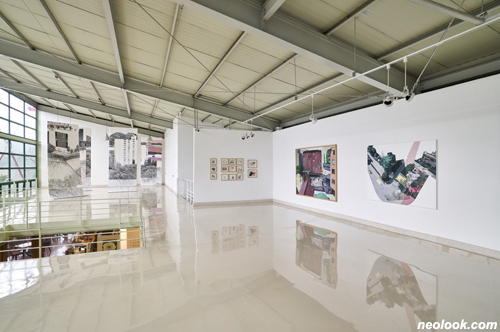- ● homepage
- ● archives
- ● restoration
- ● books
- ● big banners
- ● post board
- ■ neo's search
- ■ about us
- ■ 게재방법 안내
- 개인정보처리방침

- [email protected]
- Tel. 02_335_7922
- Fax. 02_335_7929
- 10:00am~04:30pm
- 월요일~금요일
- 3/3(월) 대체공휴일

외딴 점이 사는 외딴 섬 A Sole Dot Living on an Island
이주연展 / LEEJUYEON / 李柱娟 / painting 2022_0311 ▶ 2022_0508
● 위 이미지를 클릭하면 네오룩 아카이브 Vol.20200804a | 이주연展으로 갑니다.
이주연 블로그_blog.naver.com/leejy9073 인스타그램_@juyeon_artwork
별도의 초대일시가 없습니다.
관람료 / 성인(만19세 이상) 3,000원 / 학생(초,중,고) 2,000원 미취학 아동 및 65세 이상 무료관람
관람시간 / 10:00am~06:00pm
리각미술관 LIGAK MUSEUM OF ART 충남 천안시 동남구 태조산길 245 Tel. +82.(0)41.566.3463 ligakmuseum.co.kr
외딴 섬에 사는 어중간한 누군가의 '풍경-자화상' - Ⅰ. 프롤로그 ● 작가 이주연의 신작 개인전은 이전 전시의 맥을 이으면서 도시와 인근의 자연이 어우러진 풍경을 선보인다. 전시 주제는 '외딴 점이 사는 외딴 섬'이다. 우리는 여기서 '외딴 점'은 작가 자신을 은유한 표현이고, '외딴 섬'은 그녀가 위치한 삶의 시공간적 배경을 은유한 것임을 어렵지 않게 알 수 있다. 그런 면에서 이번 전시는 작가 이주연이 자신을 성찰하고 자신에게 건네어 주는 '은유의 풍경-자화상'이라는 성격의 '선물'이라고 할 만하다. 어찌 보면 '외딴 점이 사는 외딴 섬'이라는 것이 '소외를 안고 사는 현대인이 거주하는 삶의 맥락'이기도 하다는 점에서 그녀의 전시는 불특정 다수에게 헌사하는 '은유적 풍경-초상'이라고도 할 수 있겠다. 그것이 무엇이고 우리에게 어떠한 모습으로 선보이고 있는가?
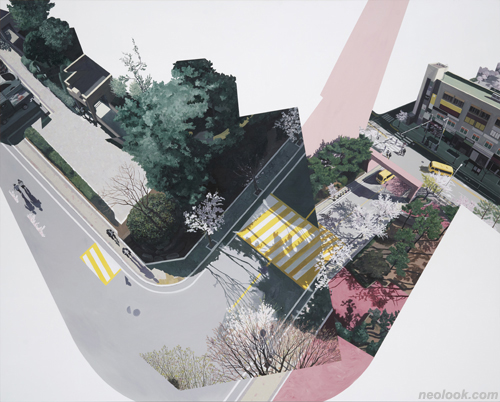
- 이주연_외딴 섬_캔버스에 아크릴채색_130.5×162.3cm_2021
Ⅱ. 홈 파인 공간 속 외딴 섬 ● 작가 이주연은 도시 풍경, 구체적으로 말해, 도심에서 이격된 도시 변두리 풍경을 그린다. 그것은 그녀가 삶의 일상으로 맞닥뜨리고 있는 거주의 공간이다. 그곳은 아직 개발되지 않거나 난개발된 '여백의 풍경' 사이사이에 '밀집된 아파트 단지'와 같은 외딴 섬들이 드문드문 놓여 있는 곳이다. ● 작가는 이 외딴 섬들에 주목한다. 풍경 속에 홈을 파고 수로를 만들고 벽도 쌓아 올려 만든 외딴 섬! 우리는 안다. 문명의 공간은 들뢰즈(G. Deleuze)가 살피고 있듯이, 자연의 매끈한 공간(l'espace lisse) 위에 '틈'을 만든 '홈 파인 공간(l'espace strié)'인 것을 말이다. 고대 인류가 유목에 안녕을 고하고 정주(定住)를 시작하면서 짓기 시작한 셸터(shelter)는 이러한 '홈 파인 공간'의 원형(原型)이다. 비바람과 맹수의 위협으로부터 자신을 보호하기 위해 구축했던 피난처로서의 셸터는 인간 집단 내 구성원들 사이에서 벽으로 인한 틈과 거리를 만들었다. 이 거리를 중재하고 통제할 수장을 뽑고 위계를 만들면서 외려 지배와 피지배를 공고히 한 문명은 집단 내 구성원들 사이에 불신과 소외를 야기할 뿐이다. 오늘날 아파트의 옆집에 누가 사는지 모르는 것은 비난거리가 되지 않는다. 문명 스스로 가둔 '홈 파인 공간' 속 '외딴 섬'으로서 누리는 자유이자 한편으로 자발적으로 선택한 소외인 까닭이다. ● 작가 이주연은 작품 「외딴 섬」에 이러한 자유와 소외의 이중 경험을 표현한다: "아파트 단지 내에는 사람이 참 많이 다니지만 조금만 벗어나면 허허벌판이다. 외부와 단절된 느낌이지만 단지 내에는 아이부터 어르신들까지 북적북적하고 사람 냄새가 난다. 특히 이사한 직후에는 아이들이 간식을 사 먹고, 소리 지르며 이야기하고, 자전거와 킥보드를 타고, 놀이터에서 뛰어다니는 모습이 낯설었다. 고립에 익숙해가던 나에게 환상 같기도 하고, 어린 시절의 기억을 영화나 연극처럼 생생히 보는 듯했다." 작가의 말대로 도시 외곽의 아파트 단지는 도시 전체 공간에서는 허허벌판 속 '외딴 섬'처럼 고립된 소외의 공간이지만, 그 안의 거주자들, 특히 노인과 아이들에게는 열린 공간이자, 소통의 공간이다. ● 이주연은 이 '은유의 섬'을 흥미롭게 지켜보면서 작품 「외딴 섬」을 완성했다. 그녀는 이 작품에 자신의 아파트 층에서 내려다본 아파트 단지의 풍경을 담았다. 봄꽃이 흐드러지게 핀 가로수의 그림자가 길게 드리운 오후, 노란 횡단보도가 내려다보이는 단지 내 도로와 그 위를 걷는 거주민들, 그리고 야트막한 인근의 상가 건물이 어울려 만드는 조용한 풍경은 캔버스 화면에 마치, 초현실주의 화가들이 낯선 공간을 만들기 위해 즐겨 사용했던 조형 언어인, 포토 콜라주(photo collage)처럼 표현되어 있다. 즉 피사체에 대한 시점(視點)과 시점(時點)이 각기 다른 사진 이미지들이 절단면의 경계를 만들면서 하나의 화면 안에 중첩되는 포토 콜라주처럼, 이 작품은 이질적인 두세 화면이 '홈 파인 공간'처럼 서로를 경계를 두고 만난다.
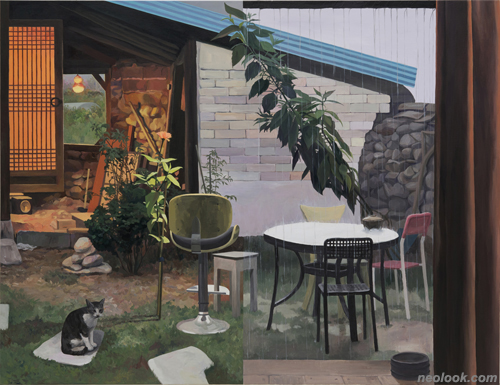
- 이주연_어떤 집_캔버스에 아크릴채색_112×145.4cm_2021
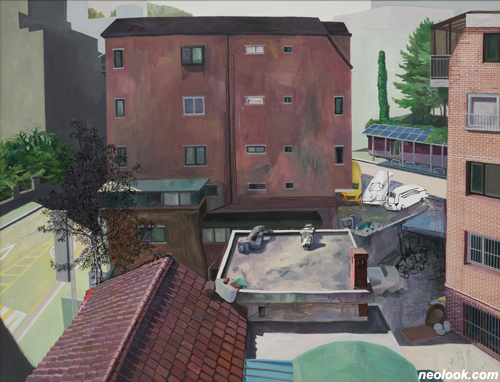
- 이주연_두 개의 창 밖_캔버스에 아크릴채색, 마커펜_160.7×207.6cm_2020
다른 작품 「어떤 집」에서 이러한 포토 콜라주의 효과는 극명하게 드러난다. 이 작품에는 일견 동일해 보이지만 엄연히 다른 시점(視點)으로 표현한 집을 볼 수 있는데, 각기 밤과 낮이라는 이질적인 시점(時點)을 함께 표현하고 있다. 동일한 파란색 지붕을 이고 있는 좌측 집은 토속적인 한옥 구조를 지닌 밤의 풍경을, 우측 집은 시멘트 블록으로 된 외벽을 한 채 비 내리는 낮의 풍경을 담고 있다. 동일한 집의 외부와 내부를 함께 보여주고 있는 것처럼 보이기도 하지만, 그녀는 좌측 하단의 잔디와 우측 하단의 마루의 절단면을 명확히 시각화함으로써 이 작품이 두 개의 다른 시점(視點)과 시점(時點)으로 화면을 구성한 포토 콜라주 방식의 결과물임을 드러낸다. ● 또 다른 작품 「두 개의 창 밖」은 작가의 작업실에 있는 두 개의 창을 통해서 보이는 외부 풍경을 각기 다른 시점(視點)으로 이동하면서 보이는 대로 그린 것이다. 여기서 완성된 그림은 두 시점을 콜라주한 것임에도 불구하고 결과물은 하나의 시점으로 된 풍경처럼 보이는데, 그러한 까닭은 두 개의 창이 인접한 거리에 있는 까닭도 있거니와 마치 포토몽타주(photomontage)처럼 자연스럽게 두 시점을 이어붙인 까닭이기도 하다. 이러한 포토몽타주의 방식은, 대개의 포토 콜라주가 잘린 면 외부에 여백을 남기는 것과 달리, 여백을 지우고 마치 원래 '거기 있었다'는 듯 천연덕스럽게 이미지를 위장한다.
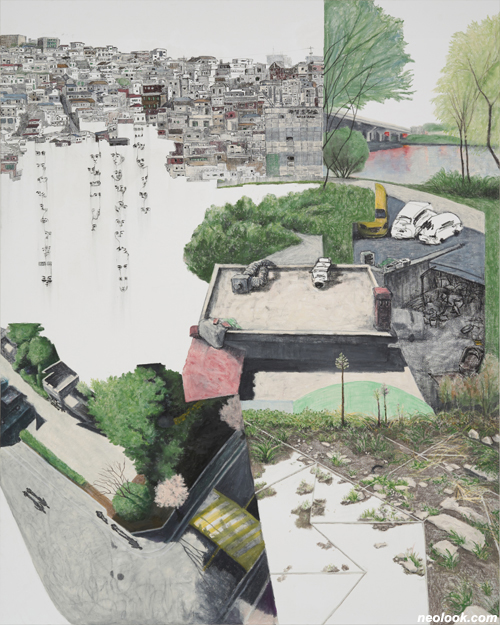
- 이주연_조각들_캔버스에 오일스틱, 오일파스텔_227.3×181.8cm_2022
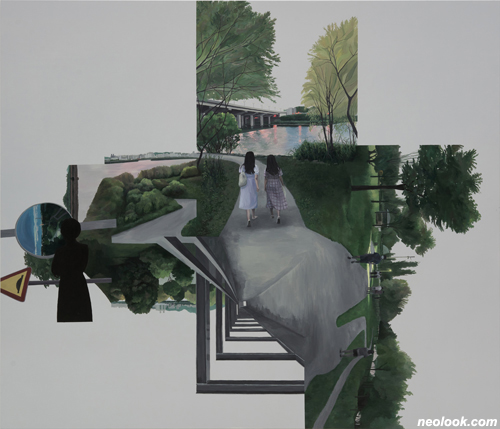
- 이주연_찰나의 숲_캔버스에 아크릴채색_140×163cm_2021
Ⅲ. 외딴 섬 속 '빈 곳' 혹은 '빈자리' ● 그리기의 조형 언어로 '포토 콜라주'의 제작 방식을 차용하는 이주연의 작업은, 앞서 언급한 작품 「외딴 섬」이나 도시공원을 시점(視點)이 다른 네 개의 화면을 전개도처럼 펼쳐놓은 작품 「찰나의 숲」 등 다수의 작품에서 마치 '홈 파인 공간'처럼 절단된 여백을 남긴다. 후자의 작업에서, 공원 산책로를 지나는 두 여인을 중심에 두고 네 방향으로 드러누운 장면들 옆으로 남겨진 회색의 여백은 마치 실제 '포토 콜라주'가 올라가 있는 바탕과 같은 효과를 유발한다. ● 포토 콜라주의 효과가 작동하는 이주연의 작품에서 '여백'은 무슨 의미를 지니는가? 흔히 여백은 쓰임새로 사용되지 못하고 버려진 잉여의 공간 혹은 주요 사건으로부터 이탈한 부재와 결핍의 공간으로 간주되지만, 그녀에게 여백은 이질적인 이미지의 만남을 수용하는 존재의 장이자, 이미지의 경계면들이 만나는 접점을 열어두는 생성의 공간으로 인식된다. ● 그렇지만 이주연의 작품 속 여백이 동양철학의 공즉시색(空卽是色)이라는 가르침대로 '비어 있음(空)' 자체가 '만물(色)'과 같은 것은 아니다. 그녀에게 여백은 현재로선 조용한 무엇이지만 언젠가는 무엇인가 채워질 가능성을 잉태한 '생성을 위한 잠재태(virtualité)의 공간'으로 간주된다. 작가 노트를 살펴보자. "공터를 보면 왠지 퍼즐판 같다. 주어진 공간에 알맞은 크기로 건물이 +++지어질 것을 상상해서 그런 걸까. 건물과 건물 사이에 빈 곳을 보면 얼른 무언가로 다시 채워야만 할 것 같다. 갑자기 비어있는 흙바닥을 보면 어색하고 허전하다. 늘 빼곡하게 채워져 있는 도시 속에서 느닷없이 생니가 빠진 느낌이다. 흐트러져있는 공터 자체가 반듯한 퍼즐 조각으로 맞추어 완성되길 기다리는 듯 보이기까지 한다." ● 작품 「미완성 퍼즐」에서 우리는 빨간 벽돌로 지어진 건물 앞에 잡초가 우거진 채 자리한 어수선한 흙바닥의 공터를 볼 수 있다. 바닥에 홈을 파고 만들어진 '수직의 공간'은 안과 밖의 경계를 나누었지만, 수평의 공간은 공터로 남아 생성을 위한 잠재태의 공간으로 자리한다. 그곳에는 흰색의 띠들이 '무엇인가 생성될 가능성'의 경계를 퍼즐처럼 구획한다. 또 다른 작품 「미완성 퍼즐 2」에서는 건물들이 둘러싸고 있는 공터에, 파란 방수천이 공사 현장의 무엇인가를 뒤덮고 있는 모습을 선보인다. 어수선한 이곳을 무엇인가 정리하려는 듯, 흰색의 띠는 공터를 퍼즐처럼 구획해 놓았다. ● 이주연이 '외딴 섬'으로 표현한 일상의 삶에서 만난 공터, 즉 '빈 곳'은 어떤 면에서 '빈자리'처럼 간주된다. 전자가 '비어 있는 상태' 자체를 강조한다면 후자는 '무엇이 혹은 누군가 있어야 할 곳'을 상정한다. 즉 그녀는 공터를 그저 '빈 곳'으로 간주하기보다는 무엇인가 채워지거나 생성될 '빈자리'로 바라보면서 자신이 꿈꾸는 생성의 공간으로 변주한다. 상상으로 만드는 '현실의 재구성'인 셈이다. ● 이러한 관심 때문일까? 작품들은 넓은 공터뿐만 아니라 삶의 공간에서 목도하는 비좁은 '틈'과 '사이'에 주목하면서 '빈자리'에 관한 생성의 꿈을 펼친다. 작품들은 건물 외벽에 생긴 '틈', 건물 아래로 뚫린 '통로', 건물과 건물 '사이'를 생성을 위한 공간으로 간주한다. 그도 그럴 것이 이주연은 A와 B의 경계를 공고히 하는 '틈'과 '사이'를 양자를 위한 소통과 화해의 공간으로 내주려는 사유에 골몰한다: "공간의 안과 밖을 이루는 경계들이 모이면 다양한 집합체를 이루게 된다. 각각의 공간들은 분리된 듯하지만, 상대적인 안과 밖, 통로의 역할이 생기면서 연관성이 생겨난다." 이러한 차원에서 캔버스라는 프레임 안에 경계의 집합체를 끌어와 탐구하는 작품들은 공간의 문제에만 국한되지 않고 시간의 문제의식으로까지 확장하게 된다. 빈자리를 야기한 과거, 현재의 빈자리, 그리고 빈자리를 메울 무엇인가가 생성될 미래까지 성찰할 수 있는 것이다.

- 이주연_미완성 퍼즐 2_캔버스에 아크릴채색, 마커펜_65.1×100cm_2020
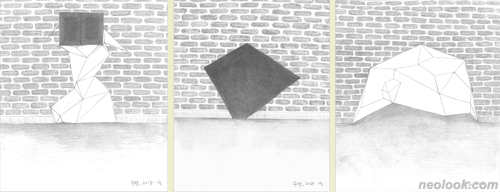
- 이주연_무제_종이에 연필_16×13.8cm×3_2018
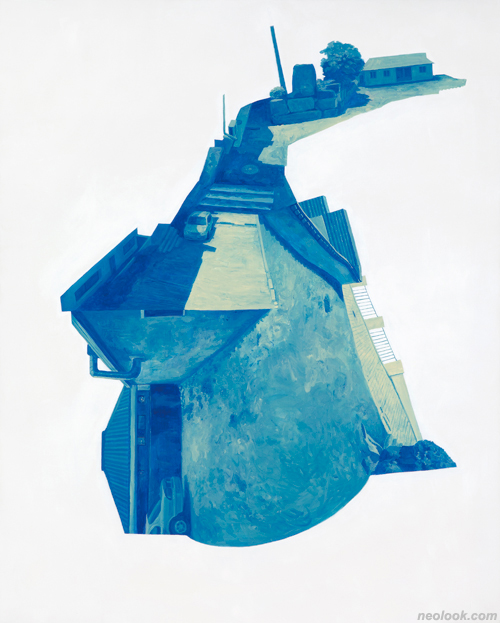
- 이주연_정릉 4동_캔버스에 아크릴채색_162.2×130.3cm_2014
Ⅳ. 외딴 섬 속 외딴 점 - 어중간한 누군가 ● 그런데 이주연은 자신의 작업에서 왜 이러한 도시 외곽의 공간을 특별히 소재로 삼고 '틈', '사이', '여백'을 통해 유독 '빈 곳'과 '빈자리'에 관심을 기울이는 것일까? 앞서 언급했듯이 자신이 거주하는 도시 외곽의 아파트 단지를 '외딴 섬'으로 은유하고 그곳을 자신의 심리를 투영하는 공간으로 간주하고 있기 때문이다. 그녀는 "풍경 속에 사람의 모습이 등장하지는 않지만, 오히려 사람에 대해 생각을 하게 된다"고 고백하면서 주거지 주변에 쓰레기로 버려진 많은 사물에서 인간관계의 문제를 성찰한다. 그것은 서로 독립된 사물일 뿐이지만, 작업 속으로 들어와 서로의 경계를 풀고 상호 소통하면서 관계의 문제로 이어지고 인간관계의 문제로 확장된다. 그녀에게 있어, 도시 외곽의 풍경과 더불어 '빈 곳'과 버려진 사물 속에서 발견하는 은유의 인간관계에 대한 심리, 즉 "소외나 군중 속의 고독 같은 쓸쓸함 등의 감정"은 작업을 이어가는 힘이다. ● 여기서 작품 「한 어중간한 사람이 있었다」를 살펴보자. 각각의 종이를 총 4장으로 구성한 가로 1.5m, 세로 4m 크기의 이 작품은 오일 스틱과 오일 파스텔로 그린 도시 외곽의 거대 풍경이다. 기존의 작품에서처럼 이 작품도 절단된 다시점의 이미지들이 포토 콜라주의 방식으로 서로 만나는데, 여기에는 빌딩, 아파트 단지와 가로수, 정원의 넝쿨, 자연의 숲속뿐 아니라 파편화된 사람의 이목구비가 한데 어지러이 뒤섞여 있다. 여기에 덧붙여 4장의 이미지에 각각 작가 노트와 같은 단상을 텍스트로 기록해 놓음으로써 사물에 투영된 자신의 심리를 드러낸다.
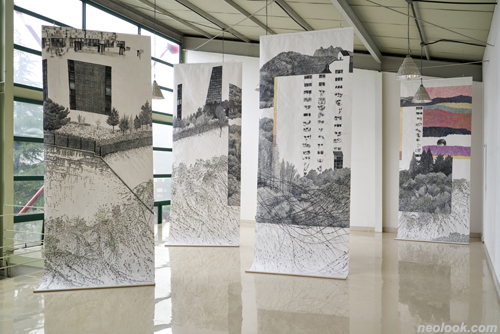
- 이주연_한 어중간한 사람이 있었다_4장의 종이에 오일스틱, 오일파스텔_400×150cm×4_2022
이러한 텍스트를 이끄는 내러티브는 자신을 삼자화해서 표현한 '어중간한 누군가'라는 주인공을 등장시킨다. '분주하게 살고 있지만, 딱히 개성이 있는 것도 아닌 애매한 그림을 그리는 어중간한 그, 여러 사람으로부터 끊임없이 칭찬, 격려, 조언, 비판을 받는 어중간한 그, 남들보다 모자라지 않지만 그렇다고 특별나지도 않은 어중간한 그'와 같은 식으로 표현되고 있는 내러티브의 주인공은, 언제나 긍정과 부정, 확신과 불신, 공동체 귀속과 소외를 오가는 가운데 살고 있는 작가 자신이다. 그런 점에서 이 작품은 그녀 자신을 투영한 자화상이라 할 만하다. 가히 '외딴 섬에 사는 외딴 점'인 것이다. ● 관람자들은, 네 쪽으로 분리된 이 거대한 작품 사이사이를 거닐면서 또한 우리가 앞에서 언급했던 작품들을 찬찬히 들여다보면서 그리고 에스키스처럼 작업한 14점의 드로잉 소품들을 둘러보면서, 분리되었지만 유기적으로 연결된 하나의 공간, 그리고 하나의 세계이지만 독립된 여러 세계를, 마치 자신의 자화상인 듯, 경험할 수 있을 것이다.
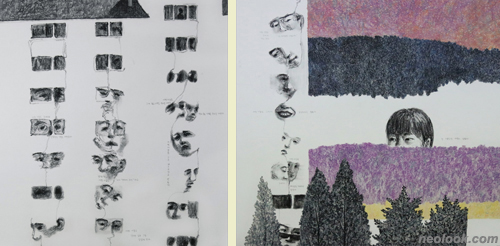
- 이주연_한 어중간한 사람이 있었다_4장의 종이에 오일스틱, 오일파스텔_400×150cm×4_2022_부분
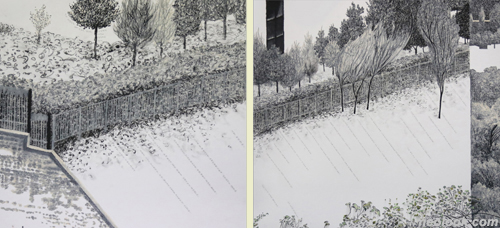
- 이주연_한 어중간한 사람이 있었다_4장의 종이에 오일스틱, 오일파스텔_400×150cm×4_2022_부분
Ⅴ. 에필로그 ● 작가 이주연은 자신이 거주하고 있는 도시 외곽의 아파트 단지를 '외딴 섬'으로 은유하면서 그것을 다양하게 변주하는 풍경을 화폭에 담아왔다. 특히 자신의 일상에서 흔하디흔한 사물에 관심을 기울이고 '외딴 점'으로 은유한 자신을 투영하면서, 자유와 소외와 같은 사물과의 관계에 관해 관심을 기울인다. '작가의 은유화된 자신'을 풍경에 투사한다는 차원에서 필자는 그녀의 작업을 스스로에게 선사하는 '은유의 풍경-자화상'이라고 정의했다. 한편 그것은 작가와 공감하는 불특정 다수에게 헌사하는 것이기도 하다. ● 그녀의 작품들을 다시 들여다보자. 작품 속에서 직조하는 사물과 사물이 생성하는 관계는 마치 오늘날 SNS에서 사용되는 해시태그(#)처럼 서로의 관계를 잇고 하나의 전체상을 만든다. 이주연은 이러한 관계와 전체상을 포토 콜라주 기법의 회화로 실험하면서 이미지와 이미지 사이의 경계 문제를 성찰한다. 사실 그 경계란 그녀가 주시했던 공간과 사물의 '틈, 사이, 빈 곳'에 대한 관심으로부터 촉발한 것이다. 이러한 '빈 곳'을 '폐기된 잉여물, 부재의 공간'으로 바라보기보다 '빈자리'처럼 미래의 생산을 기대하는 '생성의 장'이자 '잠재태'로 바라본 것이다. 자신을 '어중간한 누군가'라는 대체 인물로 삼자화하는 이주연의 입장에서, 미술 창작이라는 것은 어떠한 것인가? 그것은 명쾌한 답을 내리는 과정이기보다 끊임없이 '생성할 무엇'을 고민하고 문제 제기하는 것이 된다. 그것이 무엇인지 끊임없이 찾아가는 그녀의 예술 실험이 빛을 발하기 바란다. ■ 김성호
Landscape/Self-Portrait of Someone Living on an Island without Belonging to Anywhere - Ⅰ. Prologue ● Ju Yeon Lee's solo exhibition presenting her latest works features the landscape where the city and nature create a great harmony as in her previous exhibitions. The theme of the exhibition is A Sole Dot Living on an Island. One can easily infer that the 'sole dot' is a metaphor for the artist and the 'island,' for the temporal and spatial background of her life. In that sense, the exhibition may be deemed as a gift in the form of the metaphoric landscape/self-portrait that the artist presents to herself after in-depth self-introspection. Considering that an island where a sole dot lives captures the 'context of a life people live today in the midst of alienation,' her exhibition can be seen as a landscape of metaphor/ portrait dedicated to the unspecified. What is it, and how is it presented to us?
Ⅱ. An isolated island in a striated space ● Ju Yeon Lee paints urban landscape, more specifically, the landscape of the outskirts of a city, far from the downtown. It is the artist's dwelling space she faces day to day. The space is spotted with islands such as 'densely located apartment complexes' seen between 'the landscape of empty space.' ● The Artist focuses on these islands. Islands created by cutting grooves, building waterways, and raising walls in the landscape! We all know that the space of civilization is, as G. Deleuze examines, l'espace strié or striated space that creates a gap on the smooth space or l'espace lisse of nature. The shelter, which humanity began to build in the ancient time as they bid farewell to the days of a nomadic lifestyle and started to settle down, is the archetype of such a striated space. A shelter and its walls, initially built as a refuge to protect humanity from the threat of rains, storms, and wild beasts, created gaps and distances between members of the human community. Civilizations have consolidated their dominion and control by creating a hierarchy and selecting a leader to mediate and control such distances. Yet, rather than closing the gaps and distances, they have created further distrust and alienation among members of the community. Even if you do not know who lives in the next-door apartment, no one will blame you. As your ignorance represents the freedom you enjoy as an 'island' in l'espace strié as well as voluntary isolation. ● In An Isolated Island, Lee expresses this two-fold experience of freedom and alienation. "An apartment complex is home to so many people. But going only a little further, there is nothing but fields. Although looking disconnected from the outside, inside the complex is crowded and full of faces and touches of humans from toddlers to the elderly. Right after moving in, it I felt a bit unfamiliarcomfortable watching children having snacks, shouting and talking, riding bicycles and scooters, and running around in the playground. It looked like a fantasy to me having gotten used to isolation, or a childhood memory vividly played before my eyes like a film or a theatre." As she said, an apartment complex on the outskirts of a city is an isolated and alienated space in a field like An Isolated Island. However, for the residents, especially the elderly and children, it is an open space as well as a space of communication. ● Ju Yeon Lee produced her work An Isolated Island as she watched this metaphoric island with interest. She captured the landscape of the apartment complex, overlooking it from where she lives. The long shadows of the roadside trees in full bloom in the afternoon of one spring day, roads with yellow crosswalks within the complex and the residents walking on them, and low-rise commercial buildings. The quiet landscape they create in great harmony is expressed like a photo collage, a formative language that surrealist painters loved to use to create a strange, unfamiliar space. In other words, in this piece, two or three disparate scenes come together, creating a boundary in-between like l'espace strié as in a photo collage where photographic images with different viewpoints and time points on a subject are overlapped with each other in one screen, forming the boundary of cut-outs. ● In A House, such a photo collage effect is clearly displayed. In this work, the audience would see a house that looks no different at first glance but is expressed from two completely different perspectives and presents heterogeneous time points, day and night. The left-hand side of the house with the same blue roof features the landscape of night, capturing a structure of a traditional Korean house of hanok, while the right-hand side of the house with a cement block wall shows the landscape of a rainy day. It appears to show both the exterior and interior of the same house. However, she expressly visualizes the cut-out line of the lawn in the lower leftright corner and the wooden floor on the lower right side, revealing that the work is the outcome of the photo collage that puts together two different viewpoints and two different time points. ● In the meantime, Out of Two Windows paints the landscape seen through the two windows in the artist's studio, moving along different viewpoints. The completed picture is a collage of two different viewpoints, but it looks like a landscape from a single viewpoint. That is attributable to the fact that the two windows are pretty close to each other, and the two different viewpoints were joined together so naturally as if photomontage. Such an approach taken by photomontage is different from that of photo collage in most cases in that it wipes out an empty space and pretenses to have been there in the first place, while photo collage leaves an empty space on the outside of the cut-out plane.
Ⅲ. An empty place or a vacant place within an isolated island ● Ju Yeon Lee, who borrows the art-making approach of photo collage as a formative language of drawing, leaves a cut-out space like a striated space in many of her works, including An Isolated Island mentioned above and Forest of the Moment, which features four scenes painting an urban park, each from a different viewpoint, like a development view. In the latter, the empty gray space left next to the sections laid down in four directions with two women walking along a path at the center creates an effect of the background, making it look as if an actual photo collage is placed on top of the background. ● What is the significance of empty space in the artist's works where the effect of photo collage is in play? Typically, an empty space is regarded as a space of disposed surplus failing to find its use, or a space of absence and deficiency deviating from a major event. However, for the artist, an empty space is an arena of existence that accommodates the encounter between disparate images as well as a space of creation that keeps the interface between boundaries of images open. ● However, an empty space in Ju Yeon Lee's works is not the same as the oriental teaching that Matter is void and all is vanity or 'emptiness' is the 'universe' in itself. To the artist, an empty space is a 'space of virtualité for creation,' conceiving the potential to be filled with something although it is quiet at the moment. Let's turn to the artist's notes. "A vacant lot looks like a puzzle. That's probably because I imagine buildings to be built in size fit for the space. When I see an empty space between buildings, I feel urged to fill it up with something immediately. When I see a dirt ground all empty, it feels awkward and empty. It feels as if a healthy tooth is taken out all of a sudden in a city that is always perfectly filled. It even seems that the messy vacant lot is waiting to be put together with other pieces of the puzzle to complete the picture." ● In Unfinished Puzzle, we see a messy dirt vacant lot where weeds grow in front of a red brick building. The 'vertical space' created by digging grooves on the ground gives birth to the boundary between the inside and the outside, but the horizontal space remains an empty space or a space of virtualité for creation. There, white lines define the boundaries of the 'potential to create something.' like pieces of a puzzle. Another work, Unfinished Puzzle 2, shows a blue tarpaulin covering something of a construction site in a vacant lot surrounded by buildings. Again, as if to organize things in this messy place, white lines divided the empty space like a puzzle. ● The vacant lot or the empty place the artist met and described as an 'isolated island' is, in a way, 'a vacant place.' If the former highlights the 'state of being empty,' the latter assumes a 'place where something or someone should be there.' In other words, the artist views a vacant lot more than an 'empty place.' It is a 'vacant place' to be filled with something or create something. That is how she turns the empty space into a space of creation she dreams, that is, reconstruction of reality through imagination. ● Such interest may have led her to the narrow gaps and in-betweens witnessed in the space of life as well as in large vacant lots, letting the dream of creation for an empty space pan out. The works of the artist consider the 'gap' in the outer wall of a building, the 'passage' under the bottom of a building, and the 'in-betweens' of the building as a space for creation. That is so natural for Ju Yeon Lee, who is so much into presenting the 'gap' and 'in-between' that establishes and declares the boundary between A and B as a space of communication and reconciliation between the two: "When the boundaries that define the inside and outside of spaces come together, they form various assemblages. Each space looks isolated, but as relative inside and outside as well as passages are defined and given their roles, a connection is created." In that sense, the works that bring into and explore the assemblage of boundaries inside the frame of the canvas go beyond the subject of space to the subject of time. That is how these works explore the past that brought the empty space into being, the empty space in the present, and the future when something will be created to fill the space.
Ⅳ. A sole dot living on an island – someone standing in the middle ● Then, why does Ju Yeon Lee take the space on the outskirts of a city as a subject and pay special attention to 'vacant space' and 'empty place' through 'gap,' 'in-between' and 'empty space'? This is because, as mentioned earlier, the artist metaphors her apartment complex on the outskirts of a city as an isolated island and regards it as a space to project her thoughts and sentiment. "People's absence in the landscape makes us think more about people," the artist says and reflects on the issue of human relationships in many of the objects thrown away around the residential area. They are nothing but objects isolated from each other, but as they come into the artworks, tear down their boundaries, and communicate with each other, they lead the audience into an issue of relationship and expand to an issue of human relationships. The thoughts and sentiment toward human relationships metaphorically found in the landscape of the outskirts of a city, empty place, and discarded objects, that is, the alienation and loneliness, or solitude in the crowd, is the very driver behind her art practice. ● Let us turn to There was an Ambiguous Person. This oil stick and oil pastel work made of four pieces of 1.5m by 4m paper is a huge landscape featuring the outskirts of a city. As in her previous works, in this work, cut-out images from multiple viewpoints are brought together in the form of a photo collage with buildings, an apartment complex, roadside trees, garden vines, and forests, as well as fragmented human features all mixed up. To each image, the artist posts her thoughts as an artist's note, revealing her thoughts and sentiment projected on objects. ● The narrative that drives these texts introduces the protagonist, 'someone standing in the middle,' presenting the artist as a third person. 'That ambiguous person who is busy all the time but produces ambiguous paintings with no specific characteristics, that person who is constantly praised, encouraged, advised and criticized by many, that mediocre person who is not particularly worse or better than others.' The antprotagonist of the narrative expressed in such a way is the artist herself, who always goes back and forth between the positive and negative, confidence and distrust, belonging to and being alienated from a community. In that sense, this work is the artist's self-portrait reflecting herself; A Sole Dot Living on an Island. ● As the audience walks along and between this massive four-piece painting and appreciates the works we considered as well as the fourteen esquisse-like drawings, they would be able to experience a space isolated but organically connected and a single world made of multiple independent worlds as if their own self-portrait.
Ⅴ. Epilogue ● Ju Yeon Lee metaphors the apartment complex on the outskirts of a city, the place where she lives as an 'isolated island' and has painted the variations of its landscape in the canvas. In particular, she has a keen interest in the ordinary and mundane objects with nothing special in her daily life and projects her metaphorical self as a 'sole dot,' paying close attention to the relationship with objects such as freedom and alienation. In consideration of her artistic practice projecting 'her metaphoric self' to the landscape, I defined it as the landscape of metaphor/self-portrait. Yet, at the same time, it is a dedication to the unspecified who empathize with the artist. ● Let us go back to her works. The relationships created among and between objects weave the works and play the role of hashtags used in today's social networks, connecting relationships and forming one big picture. Ju Yeon Lee experiments on such relationships and the big picture and examines the issue of boundaries between images. These boundaries originate from her interest in the 'gaps, in-betweens, and empty places' of the space and objects she observed. The artist viewed such an empty place as an 'arena of creation' and virtualité waiting for the birth in the future, not a space of disposed surplus or absence. So what is art-making to Ju Yeon Lee, who presents herself as a third person, someone standing in the middle? That would be a process of constantly pondering upon 'something to be created' and raising issues rather than defining a clear, straight answer. I truly hope that her artistic experiment of constantly searching for what that is pays off and produces fruits. ■ Kim, Sung-Ho
Vol.20220311j | 이주연展 / LEEJUYEON / 李柱娟 / painting

